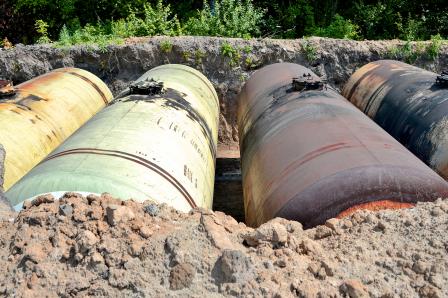Underground Storage Tanks Research
The gasoline, heating oil, and other liquid petroleum products that form the bulk of the nation’s fuels and energy supply are often stored in underground storage tanks, commonly referred to by the acronym UST. There are more than 553,000 USTs nationwide storing petroleum and other hazardous substances. Leaking can lead to serious environmental and health risks, including the contamination of groundwater, the source of drinking water for nearly half of all Americans.
EPA, states, and tribes work in partnership with industry to protect the environment and human health from potential releases from USTs. Agency research supports those efforts.
EPA researchers are:
- Studying techniques for remediating contaminated soil and groundwater from USTs.
- Developing screening tools to identify the tanks and locations at greatest risk of leaks.
- Developing new methods to conduct site characterizations and to support clean up and remediation efforts.
- Helping prevent leaks by evaluating the effect of fuel additives and emerging fuels on the integrity of existing tanks.
Exploring Groundwater Vulnerability
EPA researchers are developing tools to identify vulnerabilities to groundwater from leaking underground storage tanks. New methods will identify groundwater wells nationally, which will then be used to develop a groundwater vulnerability model at local, regional, and national scales. The tools will assist states and regions in triaging site cleanups and assessing potential cumulative impacts to groundwater supplies.
Examples and resources include the following:
- EPA Report: Relationships between Private Domestic Wells and Underground Storage Tanks: Evaluation of Mapping and Plume Transport Tool Implementations
- Presentation: Locations with High Reliance on Private Wells: Not Always Where You Think They Are
Leak Prevention and Fuel Compatibility
 Biofuels and other emerging fuels are potentially incompatible with various UST system components, potentially resulting in leaks that releases automotive fuels into the environment. EPA researchers are helping assess developments in site cleanup technologies and assessing alternative and emerging fuels for compatibility. This research will be used to update technical guidance manuals and evaluations of risks to UST system components from new fuel formulations.
Biofuels and other emerging fuels are potentially incompatible with various UST system components, potentially resulting in leaks that releases automotive fuels into the environment. EPA researchers are helping assess developments in site cleanup technologies and assessing alternative and emerging fuels for compatibility. This research will be used to update technical guidance manuals and evaluations of risks to UST system components from new fuel formulations.
Recent resouces and research results include the following:
- EPA Report: Gasoline Composition in the U.S. from Three Datasets 1976-2017
- Cooperative Agreement Report with Battelle: Suitability of Leak Detection Technology for Use in Ethanol-Blended Fuel Service
Petroleum Vapor Intrusion
Petroleum vapors from leaking underground storage tanks have the potential to enter buildings, where they might pose a risk to the health of occupants. This problem is called Petroleum Vapor Intrusion (PVI). EPA’s PVIScreen provides a resource for site managers and others to explore and better understand the dynamics of petroleum vapor intrusion. It automatically conducts an uncertainty analysis, which repeatedly runs the model with differing values of site-specific factors, or user-defined parameters to incorporate uncertainties. Typically, the model is run 1000 times using various factors and input quantities. It is compatible with EPA guidance for assessing PVI at leaking underground storage tank sites.
